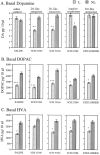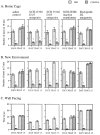Behavioral and neurochemical recovery from partial 6-hydroxydopamine lesions of the substantia nigra is blocked by daily treatment with D1/D5, but not D2, dopamine receptor antagonists
- PMID: 9133402
- PMCID: PMC6573679
- DOI: 10.1523/JNEUROSCI.17-10-03840.1997
Behavioral and neurochemical recovery from partial 6-hydroxydopamine lesions of the substantia nigra is blocked by daily treatment with D1/D5, but not D2, dopamine receptor antagonists
Abstract
To determine whether D1/D5 dopamine (DA) receptors play a role in normalization of DA extracellular levels of striatal DA and behavioral recovery after partial 6-OHDA lesions of the substantia nigra, animals were treated on days 1-8 after lesioning with the D1/D5 DA receptor antagonists SCH 23390 (0.1 mg/kg, s.c.) and SCH 39166 (1.0 mg/kg, s.c.), the inactive enantiomer SCH 23388 (0.1 mg/kg, s.c.), the D2 antagonist eticlopride (0.1 mg/kg, i.p.), or saline. Spontaneous turning behavior was assessed on days 3 and 15. Basal extracellular DA and metabolites were measured in both striata using microdialysis on days 16 and 17, 8-9 d after termination of drug treatments. On day 3, all animals turned ipsilateral to the lesion. On day 15, animals previously treated with either saline, eticlopride, or SCH 23388 showed no behavioral asymmetries, whereas animals treated with SCH 23390 or SCH 39166 turned ipsilaterally. On days 16 and 17, extracellular DA did not differ on the two sides in animals treated with saline or eticlopride and were higher on the lesioned side after SCH 23388. In animals treated with the D1/D5 receptor antagonists, however, basal levels of DA were lower on the lesioned side, showing no evidence of normalization. These results suggest a role for the D1/D5 DA receptor in the development of compensatory changes in the DA neurons that accompany behavioral recovery from partial lesions of nigrostriatal DA system.
Figures



Similar articles
-
Behavioral and neurochemical recovery from partial 6-hydroxydopamine lesions of the substantia nigra is blocked by daily treatment with glutamate receptor antagonists MK-801 and CPP.J Neurosci. 1996 Aug 15;16(16):5216-24. doi: 10.1523/JNEUROSCI.16-16-05216.1996. J Neurosci. 1996. PMID: 8756450 Free PMC article.
-
Sparing of behavior and basal extracellular dopamine after 6-hydroxydopamine lesions of the nigrostriatal pathway in rats exposed to a prelesion sensitizing regimen of amphetamine.Exp Neurol. 2004 Sep;189(1):78-93. doi: 10.1016/j.expneurol.2004.05.012. Exp Neurol. 2004. PMID: 15296838
-
Dopaminergic functional supersensitivity: effects of chronic L-dopa and carbidopa treatment in an animal model of Parkinson's disease.J Pharmacol Exp Ther. 1993 Dec;267(3):1105-11. J Pharmacol Exp Ther. 1993. PMID: 8263772
-
SCH 23390: the first selective dopamine D1-like receptor antagonist.CNS Drug Rev. 2001 Winter;7(4):399-414. doi: 10.1111/j.1527-3458.2001.tb00207.x. CNS Drug Rev. 2001. PMID: 11830757 Free PMC article. Review.
-
A review of the discovery, pharmacological characterization, and behavioral effects of the dopamine D2-like receptor antagonist eticlopride.CNS Neurosci Ther. 2008 Fall;14(3):248-62. doi: 10.1111/j.1755-5949.2008.00047.x. CNS Neurosci Ther. 2008. PMID: 18801115 Free PMC article. Review.
Cited by
-
Presynaptic involvement in the nicotine prevention of the dopamine loss provoked by 6-OHDA administration in the substantia nigra.Neurotox Res. 2002 Mar;4(2):133-9. doi: 10.1080/10298420290015863. Neurotox Res. 2002. PMID: 12829413
-
Long-lasting induction of astrocytic basic fibroblast growth factor by repeated injections of amphetamine: blockade by concurrent treatment with a glutamate antagonist.J Neurosci. 1998 Nov 15;18(22):9547-55. doi: 10.1523/JNEUROSCI.18-22-09547.1998. J Neurosci. 1998. PMID: 9801391 Free PMC article.
-
Forced limb-use effects on the behavioral and neurochemical effects of 6-hydroxydopamine.J Neurosci. 2001 Jun 15;21(12):4427-35. doi: 10.1523/JNEUROSCI.21-12-04427.2001. J Neurosci. 2001. PMID: 11404429 Free PMC article.
-
A role for the prefrontal cortex in stress- and cocaine-induced reinstatement of cocaine seeking in rats.Psychopharmacology (Berl). 2003 Jul;168(1-2):66-74. doi: 10.1007/s00213-002-1283-z. Epub 2002 Nov 20. Psychopharmacology (Berl). 2003. PMID: 12442201
-
Temporally limited role of substantia nigra-central amygdala connections in surprise-induced enhancement of learning.Eur J Neurosci. 2008 Jun;27(11):3043-9. doi: 10.1111/j.1460-9568.2008.06272.x. Eur J Neurosci. 2008. PMID: 18588542 Free PMC article.
References
-
- Abercrombie ED, Bonatz AE, Zigmond MJ. Effects of l-DOPA on extracellular dopamine in striatum of normal and 6-hydroxydopamine-treated rats. Brain Res. 1990;525:36–44. - PubMed
-
- Akimoto K, Hamamura T, Kazahaya Y, Akiyama K, Otsuki S. Enhanced extracellular dopamine level may be the fundamental neuropharmacological basis of cross-behavioral sensntization betweeen methamphetamine and cocaine: an in vivo dialysis study in freely moving rats. Brain Res. 1990;507:344–346. - PubMed
-
- Altar CA, Hanser K. Topography of substantia nigra innervation by D1 receptor-containing striatal neurons. Brain Res. 1987;410:1–11. - PubMed
-
- Bjijou Y, Stinus L, Le Moal M, Cador M. Evidence for a selective involvement of dopamine D1 receptors of the ventral tegmental area in the behavioral sensitization induced by intra-ventral tegmental area injections of d-amphetamine. J Pharmacol Exp Ther. 1996;277:1177–1187. - PubMed
-
- Cador M, Bjijou Y, Stinus L. Evidence of a complete independence of the neurobiological substrates for the induction and expression of behavioral sensitization to amphetamine. Neuroscience. 1995;65:385–395. - PubMed
Publication types
MeSH terms
Substances
LinkOut - more resources
Full Text Sources
Miscellaneous
